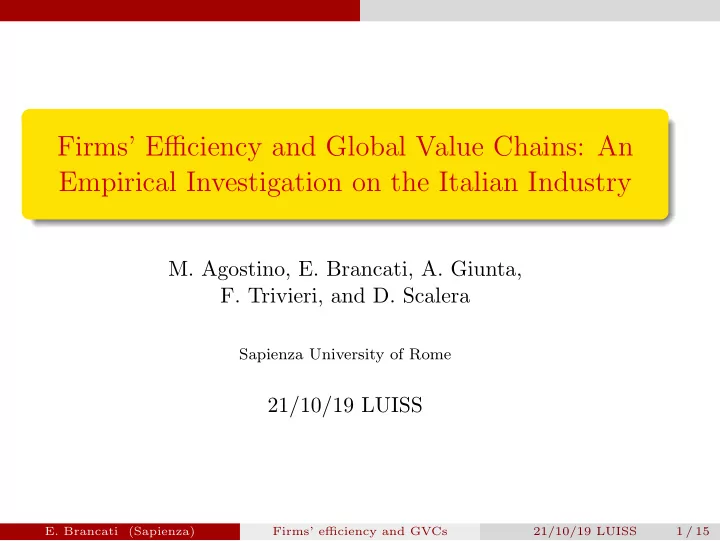

Firms’ Efficiency and Global Value Chains: An Empirical Investigation on the Italian Industry M. Agostino, E. Brancati, A. Giunta, F. Trivieri, and D. Scalera Sapienza University of Rome 21/10/19 LUISS E. Brancati (Sapienza) Firms’ efficiency and GVCs 21/10/19 LUISS 1 / 15
Research Question Effect of GVC participation on firms’ efficiency: Data Envelopment Analysis (DEA) to measure technical efficiency. Newly available Italian survey (MET) to design a taxonomy of GVC involvement. Emphasize heterogeneities across GVC participation modes and com- panies’ position along the chain. E. Brancati (Sapienza) Firms’ efficiency and GVCs 21/10/19 LUISS 2 / 15
Related Literature Vertical specialization and fragmentation of the production processes: Findlay (1978), Grossman and Rossi-Hansberg (2006), Markusen and Venables (2007), Antras and Chor (2013), among others. Many studies focused on macroeconomic consequences of upsurge of GVCs and policy issues (Koopman et al., 2011; De Backer and Miroudot, 2014, among others). Opportunity for local producers to learn from global leaders along the chain, particularly beneficial for SMEs. Neither all transactions are alike, nor benefits equally shared: cen- trality of governance. Gereffi et al. (2005) classify governance based on: complexity of transaction; degree of codifiability; capability of the firms. E. Brancati (Sapienza) Firms’ efficiency and GVCs 21/10/19 LUISS 3 / 15
Related Literature and Contributions 2 Relationship GVCs-performance often investigated through produc- tivity indicators (Agostino et al., 2015; Del Prete et al. 2017, Gio- vannetti et al., 2015; Veugelers et al., 2013). We focus on pure technical efficiency (firm ability to locate closer to the efficiency frontier): exclude sources due to technological progress and changes in scale. Propose a novel approach to identify GVCs and their participation modes (complex phenomena require complex proxies). Counterfactual analysis (PSM) and truncated regression models to estimate the impact on firms’ efficiency. We explore heterogeneity along: governance mode (relational vs. conventional GVCs); firm positioning (suppliers vs. final firms); time length of participation (new entrants vs. established GVCs). E. Brancati (Sapienza) Firms’ efficiency and GVCs 21/10/19 LUISS 4 / 15
Main Results Firms involved in GVCs are, on average, more efficient. Disproportional efficiency gains for complex and strong inter-firm relationships involving knowledge exchange. Benefits are greater for suppliers (generally suffering from a produc- tivity discount) than final companies. Gains take less time to manifest for relational GVCs, while occurring in a longer time period for conventional GVCs. E. Brancati (Sapienza) Firms’ efficiency and GVCs 21/10/19 LUISS 5 / 15
Data MET survey on the Italian industry: Three-waves survey: 2009, 2011, and 2013. Roughly 25,000 observations per wave, representative at size (all classes), region, and industry levels. Rich set of information including: purchasing/selling matrix, type of good sold & purchased, inter-firm networks, participation to the design of the final product, R&D, share of sales to other companies (final vs. suppliers), import, export, etc. In this paper: focus on SMEs and manufacturing sector only. Firm-level balance-sheet data: Cribis D&B. Select companies with complete balance sheets in the 5 years of in- terest (to compute DEA). E. Brancati (Sapienza) Firms’ efficiency and GVCs 21/10/19 LUISS 6 / 15
GVC participation A firm is considered to belong to a GVC if (at least) one of the following conditions occurs: it exports semifinished goods; it is fully internationalized (export and import); it is partially internationalized (export or import) and declares to be involved in “significant and long-lasting relationships with foreign companies”. Relational GVCs ⇒ strong relationships, high switching cost, high degree of knowledge exchange and specificity of investment: belongs to a GVC; declares to have strong ties with foreign counterparts for trade pur- poses; highly involved in the conception (R&D) and design for the final product. E. Brancati (Sapienza) Firms’ efficiency and GVCs 21/10/19 LUISS 7 / 15
DEA Retrieve the dependent variable: pure technical efficiency (max out- put given resources and technology) DEA approach (Charnes et al., 1978): efficiency based on the firm- specific distance from a piece-wise production frontiere (locus of technically-efficient input-output combinations). Allows for variable returns to scale (not all firms are assumed to be operating at their optimal scale, especially true when dealing with SMEs). Estimate relative efficiency in a given group of units. Benchmark: all observations in a given year in the belonging sector Inefficiency as measured by an excessive use of inputs given output (or too little output given inputs). E. Brancati (Sapienza) Firms’ efficiency and GVCs 21/10/19 LUISS 8 / 15
Efficiency distribution: GVC vs REL Non parametric tests (Kruksal and Wallis, 1852) confirm significance. E. Brancati (Sapienza) Firms’ efficiency and GVCs 21/10/19 LUISS 9 / 15
Efficiency distribution by positioning: GVC vs REL E. Brancati (Sapienza) Firms’ efficiency and GVCs 21/10/19 LUISS 10 / 15
Empirical Analysis GVC participation potentially endogenous: self selection of persis- tently more efficient companies (upward bias) Econometric analysis on propensity-score matching (PSM). Focus on the subset of companies with the same ex ante probability of being in a GVC and that only differ for actual participation. Robustness through bootstrapped truncated Simar and Wilson (2007) and Heckman (1979) models. E. Brancati (Sapienza) Firms’ efficiency and GVCs 21/10/19 LUISS 11 / 15
Balancing properties E. Brancati (Sapienza) Firms’ efficiency and GVCs 21/10/19 LUISS 12 / 15
Baseline results E. Brancati (Sapienza) Firms’ efficiency and GVCs 21/10/19 LUISS 13 / 15
Analysis on new entrants E. Brancati (Sapienza) Firms’ efficiency and GVCs 21/10/19 LUISS 14 / 15
Conclusions We explore the effect of GVC participation on firms’ pure efficiency. Survey data to propose a novel taxonomy of GVC participation modes. We take care of endogeneity issues by exploiting PSM and truncated- regression models and show: significant efficiency premia for firms involved in GVCs;. belonging to a GVC is not, per se, a boost, the type of relationship is critical; complex and strong inter-firm relationships involving knowledge exchange provide the best environment for efficianecy gains; benefits are greater for suppliers; gains take less time to manifest for relational GVCs. E. Brancati (Sapienza) Firms’ efficiency and GVCs 21/10/19 LUISS 15 / 15
Recommend
More recommend